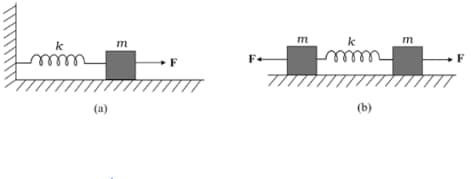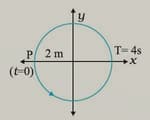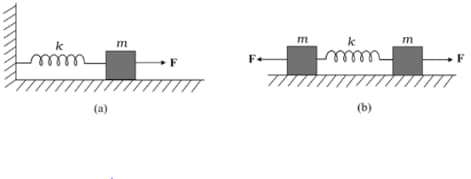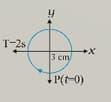Simple Harmonic Motion and Uniform Circular Motion
Important Questions on Simple Harmonic Motion and Uniform Circular Motion
Figure (a) shows a spring of force constant clamped rigidly at one end and a mass attached to its free end. A force applied at the free end stretches the spring. Figure (b) shows the same spring with both ends free and attached to a mass at either end. Each end of the spring in figure (b) is stretched by the same force .

If the mass in Fig. (a) and the two masses in Fig. (b) are released, what is the period of oscillation in each case?
Plot the corresponding reference circle for each of the following simple harmonic motions. Indicate the initial ( ) position of the particle, the radius of the circle, and the angular speed of the rotating particle. For simplicity, the sense of rotation may be fixed to be anticlockwise in every case: ( is in and is in ).
Plot the corresponding reference circle for each of the following simple harmonic motions. Indicate the initial ( ) position of the particle, the radius of the circle, and the angular speed of the rotating particle. For simplicity, the sense of rotation may be fixed to be anticlockwise in every case: ( is in and is in ).
Plot the corresponding reference circle for each of the following simple harmonic motions. Indicate the initial ( ) position of the particle, the radius of the circle, and the angular speed of the rotating particle. For simplicity, the sense of rotation may be fixed to be anticlockwise in every case: ( is in and is in ).
Figures below corresponds to a circular motion. The radius of the circle, the period of revolution, the initial position, and the sense of revolution (i.e. clockwise or anti-clockwise) are indicated.

Obtain the corresponding simple harmonic motion of the x-projection of the radius vector of the revolving particle .
Does the following function of time represent simple harmonic motion? Give period if it is periodic motion ( is any positive constant):
Does the following function of time represent simple harmonic motion? Give period if it is periodic motion ( is any positive constant):
Figure (a) shows a spring of force constant clamped rigidly at one end and a mass attached to its free end. A force applied at the free end stretches the spring. Figure (b) shows the same spring with both ends free and attached to a mass at either end. Each end of the spring in figure (b) is stretched by the same force .

What is the extension in the spring at equilibrium in the two cases?
Plot the corresponding reference circle for each of the following simple harmonic motions. Indicate the initial ( ) position of the particle, the radius of the circle, and the angular speed of the rotating particle. For simplicity, the sense of rotation may be fixed to be anticlockwise in every case: ( is in and is in ).
Figures below corresponds to a circular motion. The radius of the circle, the period of revolution, the initial position, and the sense of revolution (i.e. clockwise or anti-clockwise) are indicated.

Obtain the corresponding simple harmonic motion of the x-projection of the radius vector of the revolving particle .
Does the following function of time represent simple harmonic motion? Give period if it is periodic motion ( is any positive constant):

